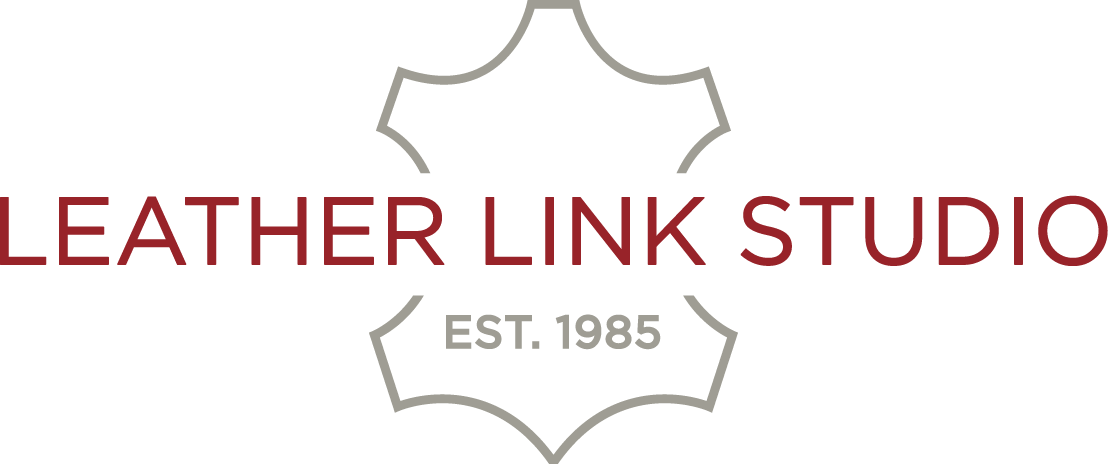Leather Link Studio Leather Glossary
This glossary includes the most important terms used within the leather industry to help you better understand the process of leather tanning.
Altered leather: Leather that has had the original surface of the skin removed (usually due to imperfections in the original surface) and a new grain embossed into the leather. This is also called corrected grain. Most top grain leathers have altered or corrected grain surfaces.
Aniline: A colorless, oily liquid made from coal tar used in making dyes and resins in organic synthesis
Aniline dye: Any dye produced synthetically from coal tar products
Aniline dyed or aniline leather: Leather that has been dyed in a dye bath with some level of dye penetration
Base dyes: Common (usually lower grade) dye colors used in custom colored leathers which are quickly made—hides are dyed in advance awaiting the spray application of custom colors
Blues: The state of hides which have been tanned once using chromium salts—these hides are light blue in color
Bovine: An animal belonging to the cattle or ox family
Breathability: An important characteristic of a full grain leather. Due to its intact grain and pore structure, full grain leather breathes which means that the leather adjusts to temperature and wicks away moisture and body heat, making it very comfortable to sit on.
Buffed leather: Leather from which the grain is removed by an abrasive or bladed cylinder for . altered or corrected grain leather
Chrome tannage: Leather tanned with chromium salts resulting in soft, mellow hides receptive to excellent color variety
Corrected grain: Commonly referred to as top grain leather—lacks an intact full grain surface and is usually heavily pigmented
Cowhide: Term specifically applied to leather made from hides of cows, although the term is sometimes loosely used to designate any leather tanned from hides of animals of the bovine species
.Drum dyeing: The application of dyestuffs to leather by the immersion of the leather in a drum that is tumbled—allows full dye penetration into the fiber
Embossed leather: Usually corrected grain, in which a pattern is applied by extreme pressure in a press to give a unique design or imitation of full grain characteristics. Sometimes leathers are embossed to make them appear to be another leather, such as embossing an alligator pattern into cowhide.
Fat wrinkle: Wrinkles in the grain of leather caused by fat deposits in the animal, that create beauty in the leather—not visible in imitation grain leather
Finish: Generally defines a surface application on the leather to color, protect or mask imperfections. More specifically, it refers to all processes administered to leather after it has been tanned.
Full grain: Leather in which the grain layer or dermis (which gives each type of leather its distinctive appearance) has not been removed
Grain (leather): The outside of the hide or skin consisting of the pores, cells, wrinkles and other characteristics which constitute the natural texture of the leather
Grain character: The natural markings on the surface of the leather
Grain, embossed: An artificial grain pressed into the surface of top grain leather from which the original grain has been removed
Grain sueded: A buffing process to raise the fibers on the grain side of a hide or skin to produce a velvet-like effect—also known as “nubuck” leather
Heavy leather: A somewhat indefinite term, generally understood to include vegetable tanned sole, belting, strap, and mechanical leathers manufactured from unsplit cattle hides
Hide: The pelt of a large animal
Leather: An animal hide which has been preserved and dressed for use
Liming: This process includes removal of the hair, preparing the hides for the tanning process
Matte finish: A flat or dull finish
Milling: A process which produces suppleness in hides
Naked leather: A dyed leather which has received no topical application that may mask or alter the natural state of the leather
Natural grain: A leather which retains the full, original grain
Nubuck: A brushed, grain-sueded leather
Patina: A natural characteristic that develops on full grain leather through normal use over a period of time
Pigmented: Leather that has been sprayed with a pigmented, opaque finish
Rawhide: Untanned or partially tanned cattle hides
Shrunken grain leather: A full, natural grain leather which is shrunken to enlarge and enhance the grain character of the leather
Split leather: Leather made from the bottom split, or reticular layer of the hide, which has an imitation grain embossed into a heavily finished pigmented surface to simulate papillary leather
Splitting: Cutting leather into two or more layers preparatory to tanning
Suede: A fibrous leather, typically made from the reticular part of the hide
Sueding: The process of raising fibers on the grain side of a hide or skin to give a velvet nap effect generally referred to as “nubuck” or “grain sueded”
Top grain: An over-used term commonly used to refer to corrected grain leather—see Corrected Grain
Unfinished leather: Normally defines aniline dyed, naked leathers with no additional application intended to finish, color or treat in any way that would alter the natural characteristics of the leather
Upholstery leather: A general term for leather processed for many uses, including furniture, automobiles, aircraft, architectural applications, etc.
Vegetable tanning: The conversion of raw hide into leather by use of vegetable tannins which produces leather with greater body and firmness than the more general method of chromium tanning
Wet blue leather: Leather which after chrome tanning has not been further processed and is sold in the wet condition.
